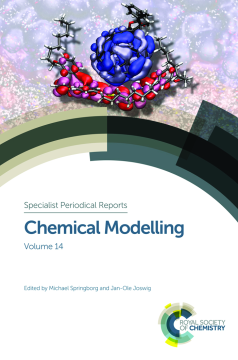
Additional Information
Book Details
Abstract
Chemical modelling covers a wide range of hot topics and active areas in computational chemistry and related fields. With the increase in volume, velocity and variety of information, researchers can find it difficult to keep up to date with the literature in these areas. Containing both comprehensive and critical reviews, this book is the first stop for any materials scientist, biochemist, chemist or molecular physicist wishing to acquaint themselves with major developments in the applications and theory of chemical modelling.
Table of Contents
| Section Title | Page | Action | Price |
|---|---|---|---|
| Cover | Cover | ||
| Contents | vii | ||
| Preface | v | ||
| Theoretical studies as a tool for understanding the aromatic character of porphyrinoid compounds | 1 | ||
| 1 Introduction | 1 | ||
| 2 Experimental methods | 3 | ||
| 3 Theoretical characterizations | 4 | ||
| 4 Applications | 11 | ||
| 5 Outlook | 33 | ||
| Acknowledgments | 34 | ||
| References | 34 | ||
| Atomistic modeling for molecular electronics and spintronics: successes and challenges | 43 | ||
| 1 Introduction | 43 | ||
| 2 Interplay between nuclear and electronic degrees of freedom | 45 | ||
| 3 Molecule-electrode and molecule-molecule interactions | 50 | ||
| 4 Signatures of spin in electron transport | 52 | ||
| 5 How accurate do we need to be? | 60 | ||
| 6 Conclusion | 63 | ||
| Acknowledgments | 64 | ||
| References | 64 | ||
| Recent progress on fermionic exchange symmetry | 71 | ||
| 1 Introduction | 71 | ||
| 2 The generalization of the Pauli exclusion principle | 73 | ||
| 3 Physical relevance of the generalized Pauli principle | 79 | ||
| 4 Reconstructing quantum states from 1-particle information | 82 | ||
| 5 Stability of the selection rule | 87 | ||
| 6 Quasipinning and correlation energy | 89 | ||
| 7 Natural extension of Hartree–Fock | 91 | ||
| 8 Further applications | 95 | ||
| 9 Summary and conclusion | 98 | ||
| Appendix A: A brief history of polytopes in quantum mechanics | 101 | ||
| Acknowledgments | 102 | ||
| References | 102 | ||
| Dynamics and electronic structure of atomic clusters | 107 | ||
| 1 Introduction | 107 | ||
| 2 Results | 114 | ||
| 3 Conclusions | 123 | ||
| Acknowledgments | 124 | ||
| References | 124 | ||
| Clusters as catalysts: advantages and challenges | 126 | ||
| 1 Introduction | 126 | ||
| 2 Computational aspects | 128 | ||
| 3 Metallic clusters | 134 | ||
| 4 Catalytic reactivity of TMO clusters | 139 | ||
| 5 Outlook and challenges | 153 | ||
| Acknowledgments | 155 | ||
| References | 155 | ||
| Modeling the oxidation mechanism of pyrite and arsenopyrite – connection to acid rock drainage | 162 | ||
| 1 Introduction | 162 | ||
| 2 Methodology | 165 | ||
| 3 Pyrite and arsenopyrite – bulk and surfaces | 173 | ||
| 4 Mechanism of pyrite oxidation | 177 | ||
| 5 Oxidation mechanism of arsenopyrite | 181 | ||
| 6 Pyrite/arsenopyrite interface | 185 | ||
| 7 Final remarks | 189 | ||
| References | 189 | ||
| Energetic processing of PAHs: isomerisation and dissociation | 195 | ||
| 1 Introduction | 195 | ||
| 2 Dissociation of PAHs | 199 | ||
| 3 Isomerisation vs dissociation | 206 | ||
| 4 Conclusion | 211 | ||
| References | 211 | ||
| From graphene to borophene the fascinating 2D materials | 217 | ||
| 1 Introduction | 217 | ||
| 2 Graphene | 217 | ||
| 3 Borophene | 233 | ||
| References | 252 |
